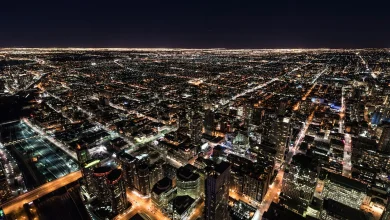Azteca Stadium residents vs. the 2026 World Cup: ‘They’re getting rich at our expense’

In Santa Úrsula Coapa, the most constant sound is no longer that of shouts, cheers, and whistles from the stadium, but that of bulldozers. The neighborhoods surrounding the Azteca Stadium — Santa Úrsula, Huipulco, and Pedregal de Carrasco — are experiencing an accelerated construction frenzy that many residents attribute to the impact of the 2026 World Cup. Mexico City will be one of the three host cities in the country for the tournament, along with Monterrey and Guadalajara. In the south of the capital, the pressure of gentrification and rising property values linked to the World Cup is already being felt in an area that has historically suffered from water shortages, insecurity, and “abandonment by the authorities,” according to its residents.
Natalia Lara, 33, has always lived in Santa Úrsula Coapa. She describes the area as “a working-class neighborhood […] Coffee carts and tamale stands set up early in the streets for people heading out to work. Many here are laborers or merchants.”
Essentially, it’s an ordinary neighborhood in the capital, but with a historic stadium. The Azteca — now called Estadio Banorte for sponsorship reasons — the largest in Mexico and the seventh-largest in the world, will also become the first stadium to have hosted three opening World Cup games next June. It is also a venue for concerts and mass events, with a capacity of 83,000, it has set the rhythm of the neighborhood for more than half a century.
“They call it the Colossus of Santa Úrsula. But it doesn’t benefit Santa Úrsula at all. We don’t even have decent sports facilities here, and we’re trapped every time there’s an event,” complains Rubén Almazán, a local resident.
Property located on San Ricardo Street (Coapa), on October 22.Emiliano Molina
Over the past year, residents have begun to notice changes. “There’s new construction on practically every street, but most don’t have permits or neighborhood notices. Even so, they’re already advertising online,” Natalia says. “Many publications say, ‘Take advantage of the added value the World Cup will bring.’ That makes it clear they want to transform the neighborhoods by force.” On the online buying and renting sites where they’re advertised, apartments are listed for almost four million pesos ($217,430), and rents can reach up to 20,000 pesos ($1,000) per month, double the amount of before.
A brief stroll through the streets is enough to notice the contrasts. The five-storey “luxury” housing projects, with roof gardens, parking, and children’s play areas, outnumber the self-built houses that are no more than three storeys high. “They bought these lots for two million pesos. Then they build apartments that sell for that price each,” Natalia complains.
Natalia Lara in front of a building under construction in Santa Úrsula Coapa.Emiliano MolinaAdolfo and Carmen Lara in Mexico City, October 22.Emiliano MolinaNorma Piñón, a resident of Santa Úrsula Coapa.Emiliano Molina
Norma Piñón, 53, is, in her own words, one of the people most affected by the construction boom. Her family founded the neighborhood before the stadium existed. A few months ago, a real estate agency bought the adjacent land. “We thought they were going to build another house, but it turned out to be an eight-storey building with 21 apartments. You can tell they’re in a hurry; they work from 7 a.m. until 9 p.m.,” she says. Norma and her family are worried about the noise, the dust, and, above all, the future of the neighborhood.
Signs reading “room for rent” can still be read on the facades, as well as advertisements offering views of the Azteca Stadium. Alejandro, 36, experienced the devastation firsthand. He rented a room two blocks from the stadium for more than three years, until the landlords saw an opportunity. “From one day to the next, the owners raised the rent from 4,000 to 8,000 pesos [$215 to $430]. I couldn’t do anything because I didn’t have a contract,” he says.
When the pressure and the price became unbearable, he decided to move. “It was amid threats of the violence already familiar here, but as a resident, you feel untouchable. Until you’re not,” Alejandro laments. He has seen that the home where he lived is now being renovated: “It’s going to be an Airbnb for the World Cup,” he says.
Gentrification and soccer
Luis Alberto Salinas, a researcher at the Institute of Geography at the National Autonomous University of Mexico, explains that major sporting events like the World Cup “bring about urban transformations.” However, he believes that the problems residents point out are not limited to the championship.
“In Santa Úrsula, there’s an acceleration of the real estate dynamic, but it didn’t start with the World Cup: the event only makes it more visible,” he explains.
According to the geographer, the active participation of the government and the private sector drives real estate investment and speculation. “Landlords can do whatever they want: raise rents, evict, or shift to short-term rentals. There’s no real regulation,” he complains. “The World Cup doesn’t create gentrification, but it can serve as a pretext to accelerate evictions and changes in the housing market.”
He asserts that accommodation platforms like Airbnb are already adjusting their strategy for the event. “It seems like everything is blocked to free up space weeks before the tournament and raise prices.”
Construction on San Federico Street, in Santa Úrsula, on October 22.Emiliano Molina
According to company data, Airbnb estimates hosting 380,000 guests during the World Cup and generating an economic impact of $3.6 billion in host cities, with the tournament also spread across the United States and Canada. In Mexico, the impact is estimated to be $558 million, a figure that excites the tourism industry, but for local residents sounds more like a threat than an opportunity.
Section 1 — the Mexico City government’s strategy to regulate gentrified areas — does not include working-class neighborhoods like Santa Úrsula. For Salinas, the plan is “a set of good intentions without legal force.” Last August, various evictions were reported in central areas strained by gentrification. At the time, those affected pointed to the World Cup as a cause of the real estate boom. For its part, the Mexican Football Federation (FMF) announced in its initial estimates that the increase in economic activity will generate revenues of $3 billion. The FMF estimates that approximately 5.5 million additional tourists will visit the country during the tournament.
Remodeling work at the Azteca Stadium (Mexico City).Emiliano Molina
Sports sociologist Samuel Martínez, from the Universidad Iberoamericana, urges greater caution when describing the effects. He clarifies that the impact will be more media-related than structural. “The 2026 World Cup is not a mega-sporting event, as there are only five matches in the city. There won’t be major public works because the infrastructure is already built. What we’ll see are cosmetic changes: paint, potholes, transportation, cycle paths. The real benefits will be private, for [Mexican broadcaster] Televisa and FIFA.” For Martínez, “talking about gentrification due to the World Cup is exaggerated,” but he acknowledges that “the effects will be felt more in the remodeling of the stadium than by the event itself.” In his interpretation, the Mexican government is using the World Cup “as a communication platform and not as an urban development project.”
World Cups are often fraught with controversy and disagreement among the population. This tournament is the first to be organized under a three-host nation system, so the responsibilities and costs do not fall on a single country. At the 2014 World Cup in Brazil, the last held in Latin America, preparations were marred by construction delays and protests from various sectors of Brazilian society, who questioned the government’s spending on the organization of the tournament, which exceeded $10.6 billion.
Workers carry out construction work on properties in the Santa Úrsula Coapa neighborhood.Emiliano Molina
“It was the World Cup for the displaced,” Salinas points out. And Martínez agrees: “In Mexico, street vendors, homeless people, and prostitution will be temporarily displaced in the area, just like in Brazil. Afterward, everything will return to normal.” The street vendors outside the Azteca Stadium are also in a state of uncertainty, knowing they will be relocated, but not when or where. “We don’t sell even half of what we did before the renovation began,” Javier says, from his street stall selling Mexican team jerseys and merchandise.
Another concern in Los Pedregales concerns basic services such as water. For more than a decade, families in the Indigenous community of Santa Úrsula and other neighborhoods in the Coyoacán municipality have been demanding guaranteed water supply to their homes, which sometimes comes out as a trickle, opaque, or full of sand. Organized through the Community Action Cooperative, they have discovered that one of the wells has belonged to Televisa, the stadium’s owner, since 2019, and have begun fighting for its expropriation. In the document, to which EL PAÍS has had access, the government grants the stadium 450,000 cubic meters of water annually, enough to supply the neighborhood for a month. “Water for the people, not for Televisa!” is one of their slogans.
T-shirt stands outside the Azteca Stadium (Mexico City).Emiliano Molina
Last May, renovation work began on the site. “Since they started, we have even less water,” Rubén complains. “They have concessions that we don’t have. They use that water to irrigate their pastures. They are getting rich at our expense.”
They have turned to the capital’s authorities to demand solutions, they emphasize. They attend hearings, gather documents, and organize meetings. “An official told me, ‘What are you worried about? You can sell soda and water and look after cars.’ That’s not fair. It’s a mockery,” Rubén says. His neighbors aren’t asking for miracles, but rather for the authorities to plan well, to consider where they’re going to house so many people, and how they’re going to manage water and traffic. “We’re not opposed to development, but we’re defending our territory.”
Sign up for our weekly newsletter to get more English-language news coverage from EL PAÍS USA Edition





